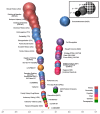Identifying biological markers for improved precision medicine in psychiatry
- PMID: 31676814
- PMCID: PMC6978138
- DOI: 10.1038/s41380-019-0555-5
Identifying biological markers for improved precision medicine in psychiatry
Abstract
Mental disorders represent an increasing personal and financial burden and yet treatment development has stagnated in recent decades. Current disease classifications do not reflect psychobiological mechanisms of psychopathology, nor the complex interplay of genetic and environmental factors, likely contributing to this stagnation. Ten years ago, the longitudinal IMAGEN study was designed to comprehensively incorporate neuroimaging, genetics, and environmental factors to investigate the neural basis of reinforcement-related behavior in normal adolescent development and psychopathology. In this article, we describe how insights into the psychobiological mechanisms of clinically relevant symptoms obtained by innovative integrative methodologies applied in IMAGEN have informed our current and future research aims. These aims include the identification of symptom groups that are based on shared psychobiological mechanisms and the development of markers that predict disease course and treatment response in clinical groups. These improvements in precision medicine will be achieved, in part, by employing novel methodological tools that refine the biological systems we target. We will also implement our approach in low- and medium-income countries to understand how distinct environmental, socioeconomic, and cultural conditions influence the development of psychopathology. Together, IMAGEN and related initiatives strive to reduce the burden of mental disorders by developing precision medicine approaches globally.
Conflict of interest statement
Dr. Banaschewski has served as an advisor or consultant to Actelion, Hexal Pharma,Bristol-Myers Squibb, Desitin Arzneimittel, Eli Lilly, Lundbeck, Medice, Neurim Pharmaceuticals, Novartis, Pfizer, and Shire, UCB, and Vifor Pharma; he has received conference attendance support, conference support, or speaking fees from Eli Lilly, Janssen McNeil, Medice, Novartis, and Shire, and UCB; and he is involved in clinical trials conducted by Eli Lilly, Novartis, and Shire and Viforpharma; he received royalities from Hogrefe, Kohlhammer, CIP Medien, Oxford University Press; the present work is unrelated to these relationships. Dr. Barker has received honoraria from General Electric Healthcare for teaching on scanner programming courses and acts as a consultant for IXICO. The other authors report no biomedical financial interests or potential conflicts of interest.
Figures

References
-
- Whiteford HA, Degenhardt L, Rehm J, Baxter AJ, Ferrari AJ, Erskine HE, et al. Global burden of disease attributable to mental and substance use disorders: findings from the Global Burden of Disease Study 2010. Lancet. 2013;382(9904):1575–1586. - PubMed
-
- Gustavsson A, Svensson M, Jacobi F, Allgulander C, Alonso J, Beghi E, et al. Cost of disorders of the brain in Europe 2010. Eur Neuropsychopharmacol. 2011;21(10):718–779. - PubMed
-
- Pangalos MN, Schechter LE, Hurko O. Drug development for CNS disorders: strategies for balancing risk and reducing attrition. Nat Rev Drug Discov. 2007;6(7):521–532. - PubMed
Publication types
MeSH terms
Substances
Grants and funding
- MR/S020306/1/MRC_/Medical Research Council/United Kingdom
- R01 MH085772/MH/NIMH NIH HHS/United States
- MR/N000390/1/MRC_/Medical Research Council/United Kingdom
- MR/R00465X/1/MRC_/Medical Research Council/United Kingdom
- U54 EB020403/EB/NIBIB NIH HHS/United States
- 695313/ERC_/European Research Council/International
- G9815508/MRC_/Medical Research Council/United Kingdom
- MRF-058-0004-RG-DESRI/MRF_/MRF_/United Kingdom
- MC_PC_19009/MRC_/Medical Research Council/United Kingdom
- MRF-058-0009-RG-DESR-C0759/MRF_/MRF_/United Kingdom
- R56 AG058854/AG/NIA NIH HHS/United States
LinkOut - more resources
Full Text Sources
Medical

